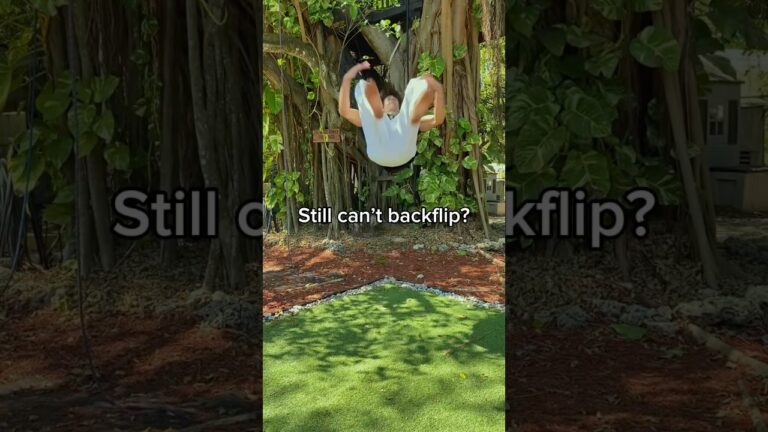[ad_1]
Okay, here’s a breakdown of how to learn a backflip, focusing on making the process as straightforward as possible:
I. Prerequisites and Safety
-
Comfort with Basic Gymnastics: Before attempting a backflip, you should be comfortable with fundamental movements like:
- Squats: Strong leg muscles are essential for the jump.
- Jumping: Practice jumping as high as you can consistently.
- Tucking: Being able to pull your knees to your chest in the air is crucial. Practice tuck jumps.
- Backward Rolls: Absolutely essential. You must be comfortable and confident rolling backward smoothly.
- Back Handspring (Optional, but Highly Recommended): A back handspring provides a great foundation.
-
Safe Practice Environment:
- Soft Landing Surface: This is non-negotiable. Use a gymnastics mat, thick crash pad, or soft grassy area (ensure it’s free of holes and debris).
- Spotter: Have an experienced spotter present, especially when you’re first learning. They can provide physical assistance and guidance, preventing injury.
- Clear Area: Ensure plenty of space around you, free from obstacles.
- Physical Conditioning:
- Warm-up: Prepare your body with light cardio (jogging, jumping jacks) and dynamic stretching (arm circles, leg swings, torso twists). Focus on flexibility in your shoulders, back, and hamstrings.
- Core Strength: A strong core is crucial for stability and control. Include exercises like planks, crunches, and leg raises in your routine.
II. Breakdown of the Backflip Motion
The backflip can be broken down into these key stages:
-
The Set (Preparation):
- Stance: Stand with your feet shoulder-width apart, knees slightly bent.
- Arm Position: Arms should be raised in front of you, parallel to the ground.
- Focus: Keep your eyes focused forward. Pick a spot to look at to help with balance.
-
The Jump (Initiation):
- Squat Down: Drop into a deeper squat, swinging your arms back behind you. This generates power.
- Explosive Extension: Immediately explode upwards and backward. Simultaneously swing your arms forcefully forward and upward. Imagine trying to reach for something high behind you.
- Head Position: As you jump, throw your head back slightly. Do not overdo it, or you risk losing control. Your head movement dictates where your body goes. Think of looking up behind you.
-
The Tuck (Rotation):
- Pull Knees to Chest: As you reach the peak of your jump, quickly pull your knees tightly into your chest. Simultaneously bring your hands down to grab your shins or knees. This tightens your body and accelerates your rotation.
- Head Position (Continued): Keep your head tucked slightly, looking at your knees.
- Spotting: Try to spot your landing as soon as possible.
-
The Landing (Control):
- Release the Tuck: As you see the ground coming up, release your tuck, extending your legs downward.
- Prepare for Impact: Bend your knees to absorb the impact.
- Arm Position: Extend your arms out in front of you for balance.
- Stick the Landing: Aim to land with your feet shoulder-width apart, maintaining your balance.
III. Drills and Progressions
Practice these drills in order to build up to the full backflip:
-
Backward Rolls: Perfect your backward rolls. Focus on rolling smoothly and quickly.
-
Standing Back Tucks (on Mat):
- Practice the jump and tuck motion on a soft surface.
- Focus on getting height and a tight tuck.
- Don’t worry about landing perfectly at first; just focus on rotation.
-
Backwards Roll to Stand:
- Start in a standing position. Initiate a backwards roll, but instead of completing the roll, use momentum to stand up again quickly. This helps with backwards movement and coordination.
-
Wall Flips:
- Stand with your back to a wall.
- Jump backward and place your hands on the wall to support yourself.
- Practice kicking over into a handstand, then pushing off the wall to land on your feet.
-
Spotting Drills:
- Have a spotter assist you with a backflip. They will help guide you through the rotation and ensure you land safely.
- Focus on the jump and tuck, letting the spotter control the landing.
- Gradually reduce the spotter’s assistance as you gain confidence.
-
Practice on an Inclined Surface:
- Using a wedge mat or small incline can help with the feeling of backwards rotation.
- Backflip on Trampoline (Optional):
- A trampoline provides extra height and allows you to focus on the rotation. This can be a good intermediate step before attempting it on a solid surface.
IV. Common Mistakes and How to Avoid Them
- Hesitation: Doubt can lead to poor execution and injury. Be confident in your abilities.
- Not Jumping High Enough: Insufficient height means you won’t have enough time to complete the rotation.
- Weak Tuck: A loose tuck slows down your rotation.
- Throwing Head Back Too Far: This can cause you to over-rotate and lose control. Keep your head movement controlled.
- Looking Down Too Early: Spot your landing as late as possible to maintain your rotation.
- Landing on Your Head/Neck: This is extremely dangerous. Always use a spotter until you are completely confident. If you’re losing the rotation, try to bail out by landing on your hands and rolling through.
V. Important Considerations
- Progression: Don’t rush the process. Master each drill before moving on to the next.
- Patience: Learning a backflip takes time and practice. Be patient with yourself and don’t get discouraged.
- Listen to Your Body: Rest when you need to. Don’t push yourself too hard, especially when you’re tired.
- Proper Technique: Focus on proper technique over speed. Correct form will prevent injuries and allow you to progress faster in the long run.
- Professional Guidance: Consider taking a gymnastics class or working with a qualified coach for personalized instruction.
[ad_2]

